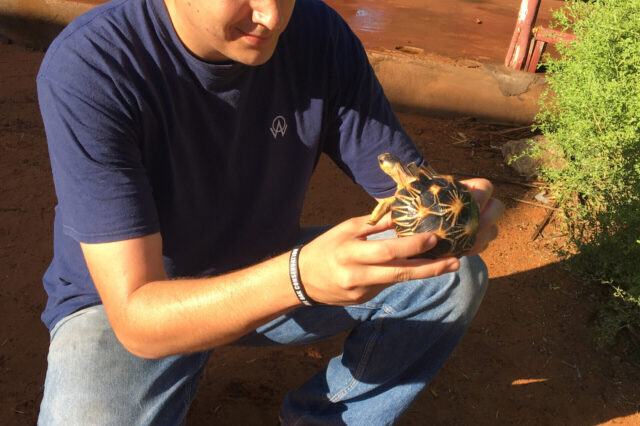UF zoological resident travels to Madagascar to rescue endangered tortoises

Earlier this year, authorities in Madagascar seized more than 10,000 endangered tortoises that poachers had crammed into a house on the island off the east coast of Africa. An international organization brought the animals to a rehabilitation facility and sent out a call to any and all veterinarians, veterinary technicians, and zookeepers for help.
Among those answering the alarm from the Turtle Survival Alliance was Justin Rosenberg, D.V.M., who had just completed a three-year zoological medicine residency through UF’s College of Veterinary Medicine.
“When this opportunity came up to travel there to help with conservation efforts in the flesh, I jumped on it,” said Rosenberg, a strong believer in protecting endangered species who has a particular passion for reptiles.
Rosenberg recently returned from Madagascar after spending three weeks helping to rehabilitate the critically endangered tortoises, which are found only on the island. The radiated tortoises, with lifespans that can reach 188 years, are named from the brilliant yellow lines radiating from the center of each dark plate of their shell.
As part of his residency, Rosenberg was working at White Oak Conservation in Yulee, Florida. Rosenberg said both UF and White Oak allowed him to take time off to go on the rescue mission and supported his efforts.
“It really just fell into place,” he said.
Rosenberg was part of the fifth wave of international responders to go to the island to try to rehabilitate the tortoises, which are targeted by poachers for food and for trade because of their unique markings.
Authorities had been alerted by the stench coming from the two-story house, according to media reports. They found thousands of tortoises that had been trapped for months without water, natural sunlight and proper nutrition, he said.
Rosenberg said he had about 100 tortoises within his immediate care, most of which had dangerous conditions such as malnutrition and dehydration.
Of the 10,000 that were rescued, approximately 1,000 of them died, most during the first two weeks after the rescue. Rosenberg said this number, while large, represented a good survival rate for a large-scale rescue.
“Historically, we would’ve expected up to 20 or 30 percent mortality,” he said. “But, the folks who went down in the early waves really jumped on it and did a great job.”
Rosenberg said his team was also able to move all the tortoises to a brand-new facility, since the previous one was at capacity when the tortoises first arrived.
The long-term plan for these tortoises is to ultimately return them to the wild, Rosenberg said. But there is a fear they could be poached again.
“There’s a lot of challenges to work through before we get there,” he said.
ATTENTION EDITOR: High-resolution photo available upon request. For media inquiries, contact Sarah Carey careysk@ufl.edu or at 352-294-4242.